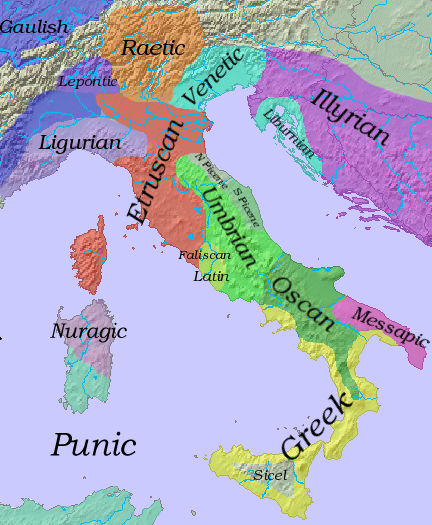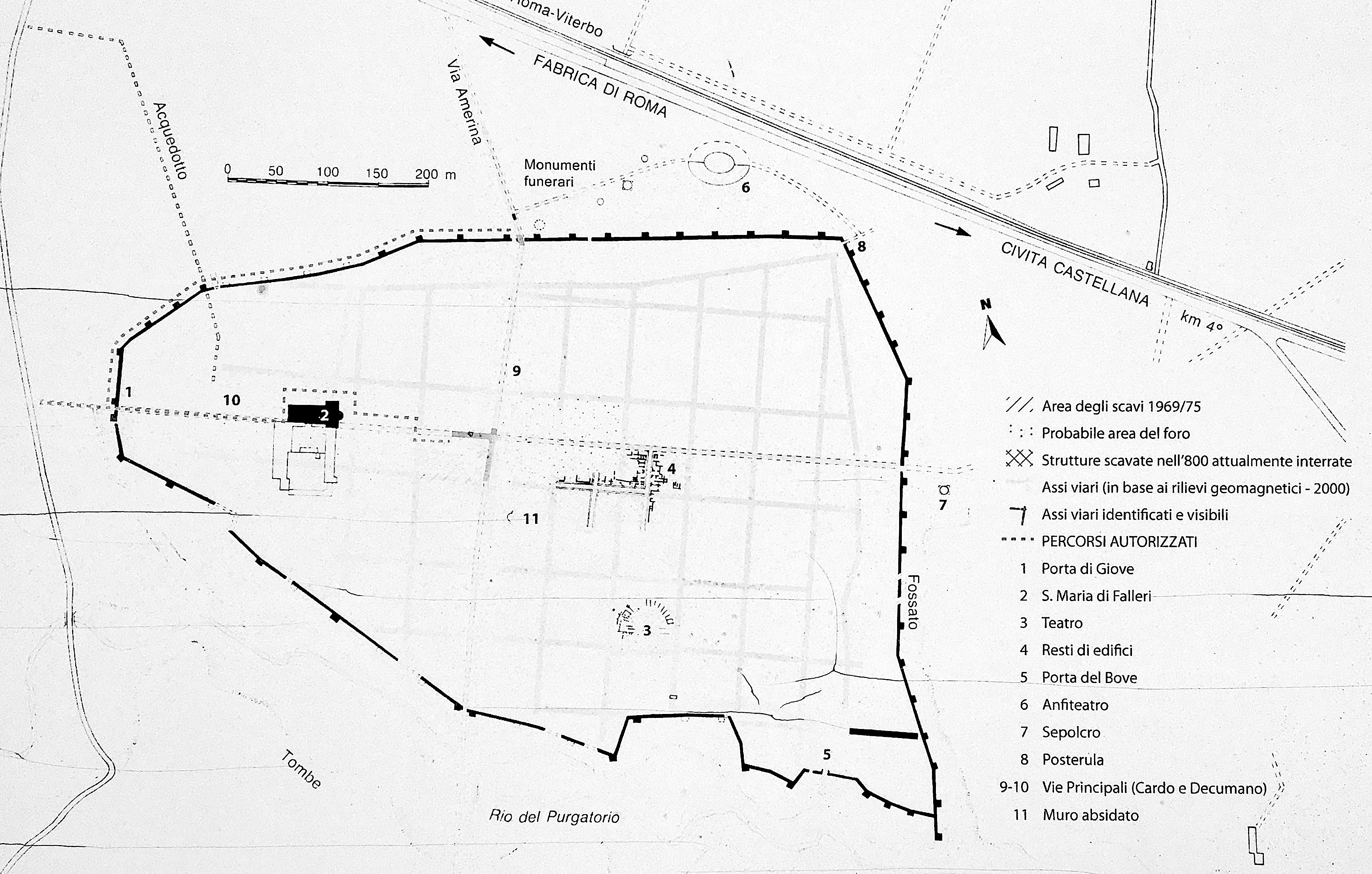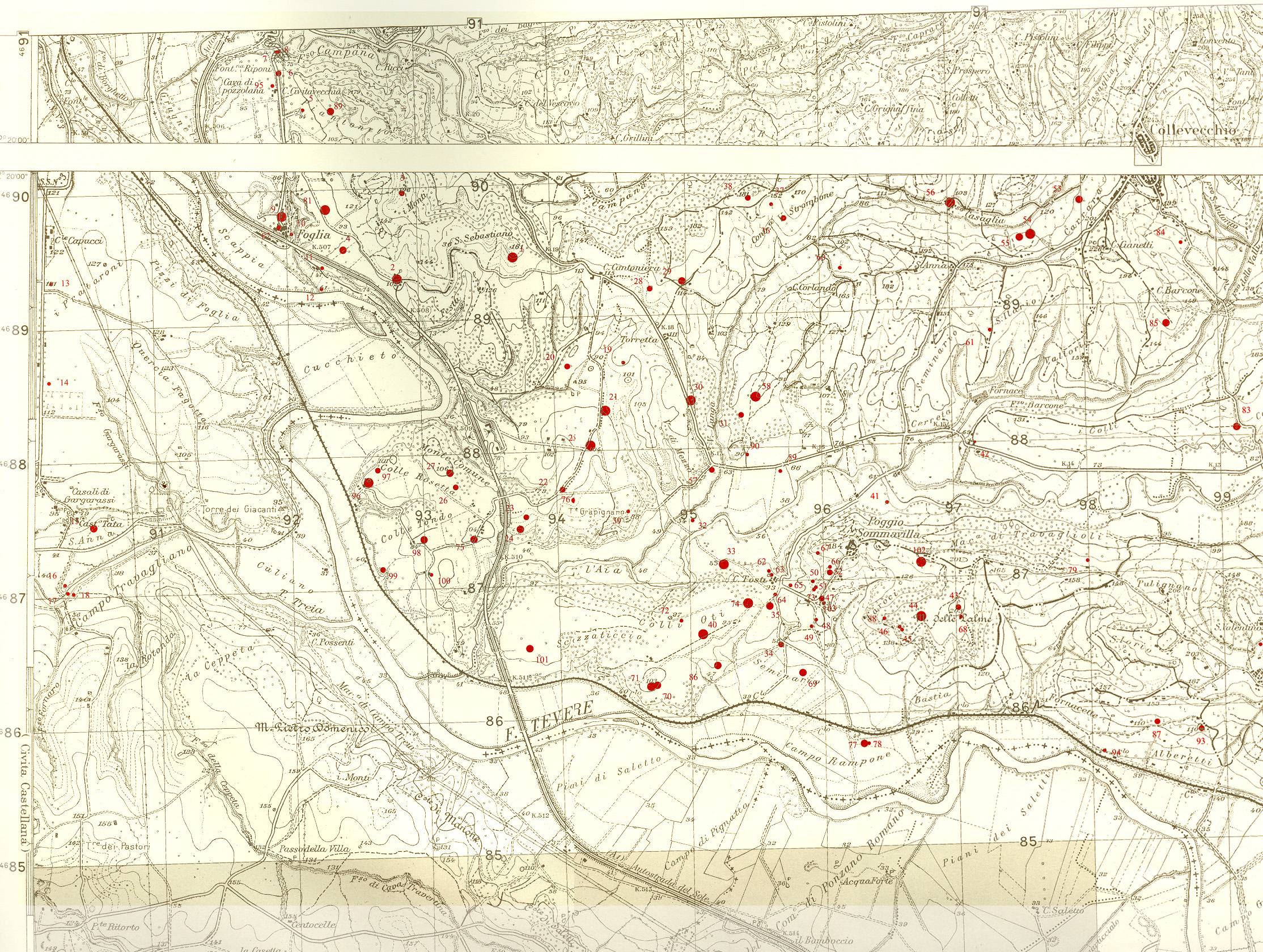|
Falerii
Falerii is a village in the municipality of Fabrica di Roma in the Province of Viterbo, Italy. Its name is better known for two nearby ancient cities, '' Falerii Veteres'' (old Falerii) and '' Falerii Novi'' (new Falerii). ''Falerii Veteres'', now Civita Castellana, was one of the chief cities of the ''duodecim populi'' of ancient Etruria. The site is about 2 km west of the course of the Via Flaminia, some 50 km north of Rome. It was the main city of the Falisci, a people whose language was Faliscan and was part of the Latino-Faliscan language group. The Ager Faliscus (Faliscan Country), which included the towns of Capena, Nepet, and Sutrium, was close to the Monti Cimini. Location The site of the original Falerii is a plateau, about 1100 × 400 m, not higher than the surrounding country (140 m) but separated from it by gorges over 60 m in depth, and only connected with it on the western side, which was strongly fortified with a mound and ditch. T ... [...More Info...] [...Related Items...] OR: [Wikipedia] [Google] [Baidu] |
Falisci
The Falisci were an Italic peoples, Italic tribe who lived in what is now northern Lazio, on the Etruscan side of the Tiber River. They spoke an Italic languages, Italic language, Faliscan language, Faliscan, closely related to Latin. Originally a sovereign state, politically and socially they supported the Etruscan civilization, Etruscans, joining the Etruscan League. This conviction and affiliation led to their ultimate near destruction and total subjugation by Rome. Only one instance of their own endonym has been found to date: an inscription from Falerii Novi from the late 2nd century AD refers to the ', "the Faliscans who are in Sardinia", where ' is the nominative plural case. An Etruscan inscription calls them the '. The Latin cannot be far different from the original name. The -sc- suffix is "distinctive of the Italic ethnonyms". Geography The Falisci resided in a region called by the Romans the ', "Faliscan Country", located on the right bank of the Tiber River betwe ... [...More Info...] [...Related Items...] OR: [Wikipedia] [Google] [Baidu] |
Falerii Novi
Falerii Novi ( English: New Falerii) was an ancient Roman walled town in the Tiber River valley, about north of Rome and west of Civita Castellana. Its impressive gate and the whole perimeter of its city walls are still visible. History According to Polybius and Livy, the Falisci people of Falerii Veteres revolted against the Roman Republic in 241 BC. Titus Manlius Torquatus was sent and during the first battle the Falerii defeated the Romans, but their cavalry was defeated. In the second battle the Romans defeated the Falerii. The war lasted six days, with the siege of Falerii Veteres taking three days. The slaves of the Falisci and half of their territory were seized, and Falerii Veteres was destroyed. The Falisci were resettled in Falerii Novi, a new town in a less defensible position on the left bank of Rio Purgatorio on a low volcanic plateau 5 km west of Falerii Veteres, and in the ''ager Faliscus''. The walls of the city made from tuff blocks had 50 towers an ... [...More Info...] [...Related Items...] OR: [Wikipedia] [Google] [Baidu] |
Falerii Veteres
Falerii Veteres, now Civita Castellana, was one of the chief cities of the ''duodecim populi'' of ancient Etruria. The site is about 2 km west of the course of the Via Flaminia, some 50 km north of Rome. The legendary foundation of the site has been linked to colonists coming from Argos. The people of the area, the Faliscans The Falisci were an Italic tribe who lived in what is now northern Lazio, on the Etruscan side of the Tiber River. They spoke an Italic language, Faliscan, closely related to Latin. Originally a sovereign state, politically and socially th ..., spoke a language that was distinct from that of the Etruscans. Following a revolt by the Faliscan tribe in around 241 BC, the Romans resettled the population of Falerii Veteres at Falerii Novi, a less defensible location. References See also * Tiber Valley * Falerii Novi * Archaeological area of Poggio Sommavilla * Foglia External links * {{Authority control Etruscan cities ... [...More Info...] [...Related Items...] OR: [Wikipedia] [Google] [Baidu] |
Civita Castellana
Civita Castellana is a town and ''comune'' in the province of Viterbo, north of Rome. Mount Soracte lies about to the south-east. History Civita Castellana was settled during the Iron Age by the Italic Falisci, who called it " Falerii". After the Faliscan defeat by the Romans, the Romans built a new city, about away, " Falerii Novi." The abandoned city was repopulated beginning in the early Middle Ages, with the new name of Civita Castellana 'City of the Castle' first mentioned in 994. In the following centuries the city was a flourishing independent commune, often disputed between the Pope and the Holy Roman Empire. Captured by Pope Paschal II at the beginning of the 12th century, the city was given as a fief to the Savelli by Gregory XIV. Sixtus IV assigned the city to Cardinal Rodrigo Borgia, the future Pope Alexander VI, who started the construction of the Rocca ("Castle"), which was completed under Julius II. Civita Castellana became an important road hub with t ... [...More Info...] [...Related Items...] OR: [Wikipedia] [Google] [Baidu] |
Veii
Veii (also Veius; ) was an important ancient Etruscan city situated on the southern limits of Etruria and north-northwest of Rome, Italy. It now lies in Isola Farnese, in the comune of Rome. Many other sites associated with and in the city-state of Veii are in Formello, immediately to the north. Formello is named after the drainage channels that were first created by the Veians. Veii was the richest city of the Etruscan League. It was alternately at war and in alliance with the Roman Kingdom and later Republic for over 300 years. It eventually fell in the Battle of Veii to Roman general Camillus's army in 396 BC. Veii continued to be occupied after its capture by the Romans. The site is now a protected area, part of the Parco di Veio established by the regional authority of Lazio in 1997. Site City of Veii The city of Veii lies mainly on a tuff plateau in area. The Valchetta flows a few miles eastward to join the Tiber River on the south side of Labaro al ... [...More Info...] [...Related Items...] OR: [Wikipedia] [Google] [Baidu] |
Third Samnite War
The First, Second, and Third Samnite Wars (343–341 BC, 326–304 BC, and 298–290 BC) were fought between the Roman Republic and the Samnites, who lived on a stretch of the Apennine Mountains south of Rome and north of the Lucanians, Lucanian tribe. * The first of these wars was the result of Rome's intervention to rescue the Campanian city of Capua from a Samnite attack. * The second one was the result of Rome's intervention in the politics of the city of Naples and developed into a contest over the control of Central Italy, central and southern Italy. * Similarly the third war also involved a struggle for control of this part of Italy. The wars extended over half a century, and also drew in the peoples to the east, north, and west of Samnium (land of the Samnites) as well as those of central Italy north of Rome (the Etruscan civilization, Etruscans, Umbri, and Picentes) and the Senones, Senone Gauls, but at different times and levels of involvement. Background By the time ... [...More Info...] [...Related Items...] OR: [Wikipedia] [Google] [Baidu] |
First Samnite War
The First, Second, and Third Samnite Wars (343–341 BC, 326–304 BC, and 298–290 BC) were fought between the Roman Republic and the Samnites, who lived on a stretch of the Apennine Mountains south of Rome and north of the Lucanian tribe. * The first of these wars was the result of Rome's intervention to rescue the Campanian city of Capua from a Samnite attack. * The second one was the result of Rome's intervention in the politics of the city of Naples and developed into a contest over the control of central and southern Italy. * Similarly the third war also involved a struggle for control of this part of Italy. The wars extended over half a century, and also drew in the peoples to the east, north, and west of Samnium (land of the Samnites) as well as those of central Italy north of Rome (the Etruscans, Umbri, and Picentes) and the Senone Gauls, but at different times and levels of involvement. Background By the time of the First Samnite War (343 BC), the southward ex ... [...More Info...] [...Related Items...] OR: [Wikipedia] [Google] [Baidu] |
Faliscan Language
The Faliscan language is the extinct Italic language of the ancient Falisci, who lived in southern Etruria at Tiber Valley. Together with Latin, it formed the Latino-Faliscan languages group of the Italic languages. It seems probable that the language persisted, being gradually permeated with Latin, until at least 150 BC. Corpus An estimated 355 inscriptions survive, mostly short and dating from the 7th to the 2nd centuries BC. Some are written from right to left in a variety of the Old Italic alphabet, derived from the Etruscan alphabet, but they show some traces of the influence of the Latin alphabet. An inscription to Ceres of c. 600 BC, found in Falerii, usually taken to be the oldest example, is written left to right. A specimen of the language appears written around the edge of a picture on a patera, the genuineness of which is established by the fact that the words were written before the glaze was put on: ', . That sample indicates that Faliscan was less conserv ... [...More Info...] [...Related Items...] OR: [Wikipedia] [Google] [Baidu] |
Marcus Furius Camillus
Marcus Furius Camillus (; possibly – ) was a Roman statesman and politician during the early Roman republic who is most famous for his capture of Veii and defence of Rome from Gallic sack after the Battle of the Allia. Modern scholars are dubious of Camillus' supposed exploits and believe many of them are wrongly attributed or otherwise wholly fictitious. Historicity The traditional account of Camillus' life comes from Livy and Plutarch's eponymous ''Life''. But these were based on a larger annalistic tradition which painted Camillus as the dominant figure in this period of history; Livy, for his part, organised his fifth and sixth books around Camillus' career (Camillus enters public office at the start of the fifth book and leaves it at the end of the sixth). Little evidence of this tradition survives, though fragments of Quintus Claudius Quadrigarius' work indicate that the myth of Camillus was well-established by the 80s and 70s BC. The ''name'' Camillus is attes ... [...More Info...] [...Related Items...] OR: [Wikipedia] [Google] [Baidu] |
Capena
Capena (until 1933 called Leprignano) is a town and ''comune'' in the Metropolitan City of Rome, Lazio region (central Italy). The town has borrowed its modern name from a pre-Roman and Roman settlement that was to its north. Geography Capena is located north of Rome (as the crow flies), above the valley of the Tiber. The old quarter stands on a hill overlooking the valley of the Fosso di Morlupo to the west, while the modern district extends into the eastern plain. The neighbouring towns are Castelnuovo di Porto, Civitella San Paolo, Fiano Romano, Monterotondo, Morlupo and Rignano Flaminio. History Ancient era The original Capena occupied the plateau of a nowadays uninhabited hill called La Civitucola, which is about northeast of a post station on the ancient ''Via Flaminia''. Its territory was known in ancient times as the ''Ager Capenas'', which was a Faliscan area adjacent (and culturally allied) to Etruria. It is frequently mentioned alongside of Veii, Falerii an ... [...More Info...] [...Related Items...] OR: [Wikipedia] [Google] [Baidu] |
Fidenae
Fidenae () was an ancient town of Latium, situated about 8 km north of Rome on the '' Via Salaria''. Its inhabitants were known as Fidenates. As the Tiber was the border between Etruria and Latium, the left-bank settlement of Fidenae represented an extension of Etruscan presence into Latium. The site of the arx of the ancient town was probably on the hill on which lies the contemporary Villa Spada, though no traces of early buildings or defences are to be seen; pre-Roman tombs are in the cliffs to the north. The later village lay at the foot of the hill on the eastern edge of the high-road, and its ''curia'', with a dedicatory inscription to Marcus Aurelius by the ''Senatus Fidenatium'', was excavated in 1889. Remains of other buildings may also be seen. History Conflicts with the Roman kingdom Originally a settlement of Etruscans, it was at the frontier of Roman territory and occasionally changed hands between Rome and Veii. In the 8th century BC during the reign of Rom ... [...More Info...] [...Related Items...] OR: [Wikipedia] [Google] [Baidu] |
Etruscan League
The Etruscan civilization ( ) was an ancient civilization created by the Etruscans, a people who inhabited Etruria in ancient Italy, with a common language and culture, and formed a federation of city-states. After adjacent lands had been conquered its territory covered, at its greatest extent, roughly what is now Tuscany, western Umbria and northern Lazio, as well as what are now the Po Valley, Emilia-Romagna, south-eastern Lombardy, southern Veneto and western Campania. A large body of literature has flourished on the origins of the Etruscans, but the consensus among modern scholars is that the Etruscans were an indigenous population. The earliest evidence of a culture that is identifiably Etruscan dates from about 900 BC. This is the period of the Iron Age Villanovan culture, considered to be the earliest phase of Etruscan civilization, which itself developed from the previous late Bronze Age Proto-Villanovan culture in the same region, part of the central European Urn ... [...More Info...] [...Related Items...] OR: [Wikipedia] [Google] [Baidu] |








